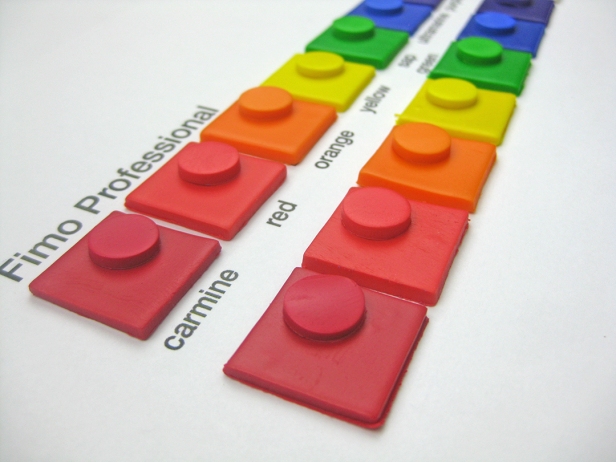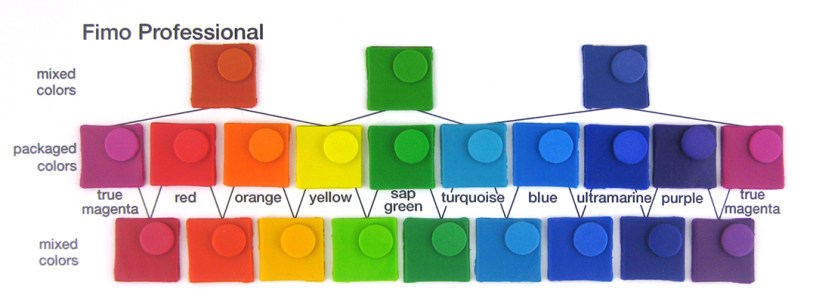
Fimo Pro (formerly called Fimo Classic) has a larger color range than what I’ve shown. I’ve found that the colors in the photo above, plus black and white, should be all that are needed to mix any color. The purple is a bit dark and shows its color better if mixed with a little white.
There are even more colors in Fimo Soft (a softer version) and Fimo Effect (metallics, glitters, stone colors, transparent colors and glow-in-the-dark). There’s also Fimo Puppen, for doll making.
All of these swatches were double-baked in two aluminum baking tins, one inverted as a lid with two small ceramic tiles inside. I’ve found that gives the best results with Fimo. See Double-Baking to Avoid Plaquing in Polymer Clay.
CLAY FIRMNESS
Fimo Pro is a firm clay that can crumble when conditioned. With patient conditioning, it becomes nice and flexible. See Conditioning Crumbly Polymer Clay. Generally, it isn’t sticky and is easy to work with.
MIXED COLORS
In the photo above, mixtures are indicated by lines drawn between colors.
In the top and bottom rows, I mixed colors that were visually halfway between the packaged colors in the second row. They weren’t mixed half and half because some colors are stronger than others.
The primaries of true magenta, yellow and turquoise mix somewhat well to make secondary colors, as shown in the top row in the photo above. Red and yellow make an orange that’s duller than the packaged orange when baked.
WHITE & TRANSLUCENT


White Fimo Pro turns orangish if baked too much. I’ve found it stays the whitest when double-baked and protected by two aluminum baking pans, one inverted as a lid. See Baking Polymer Clay Without Yellowing or Cracking.
Translucent Fimo can also turn quite orange. The longer you bake it, the darker orange it gets. It plaques a lot if not double-baked. See How to Avoid Plaquing in Polymer Clay.
COLORS THAT DARKENED WHEN BAKED
Colors that darkened noticeably when baked:
- sap green
- green
- turquoise
- blue
- ultramarine
- purple
- magenta
Colors that darkened a little when baked:
- orange
- violet
Red and yellow remained quite true.
COMPENSATING FOR COLOR SHIFTING

I compensated for color shifting by adding white or yellow. The photo above shows that they’ve improved. Most could benefit from even more white, as they’re still darker than the raw clay circles in the lower left corners.
Yellow can be used with orange or green, because they already contain yellow. The end result is a bit more vibrant than when mixed with white. Yellow is a weaker color, so it takes quite a bit.
For other colors that shift, adding white works. I’ve heard of adding translucent, but translucent has its own set of challenges, as mentioned above.
Test these methods of compensating by baking small swatches before making a project.
DOUBLE-BAKING HELPS FIMO PRO
The surface of Fimo Pro has almost no bumps when double-baked. See photos below. Translucent Fimo has almost no plaques when double-baked and it stays much lighter in color.
When baked only once, the green, ultramarine, purple and white darkened slightly more and the translucent darkened considerably.


AVAILABILITY
I generally buy Fimo Pro at Hobby Lobby or online at Polymer Clay Express or Sunny Day Crafts.
CONCLUSION
Many Fimo Pro colors shift when baked:
- sap green
- green
- turquoise
- blue
- ultramarine
- purple
- magenta
Some colors shifted less:
- orange
- violet
This can be corrected with some white and/or yellow.
White and translucent can turn orangish and darken the more they’re baked. Fimo Pro plaques a lot. These issues can be corrected fairly well by double-baking.
Fimo Pro is a firm clay that can crumble and takes a little patience to condition. See Conditioning Crumbly Polymer Clay for one method that helps. It generally isn’t sticky and is easy to work with. Fimo Soft is softer.
Official Fimo site: https://www.staedtler.us/en
P.S. I bought all these products myself and received nothing from the manufacturers.

